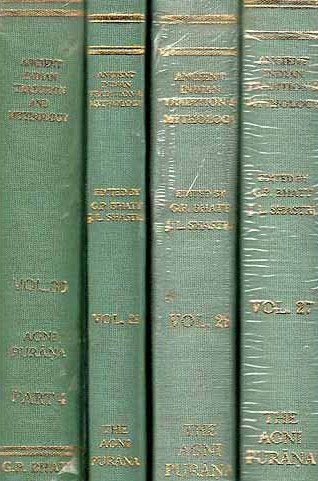The Agni Purana
by N. Gangadharan | 1954 | 360,691 words | ISBN-10: 8120803590 | ISBN-13: 9788120803596
This page describes Description of the different types of Drama (nataka) which is chapter 338 of the English translation of the Agni Purana, one of the eighteen major puranas dealing with all topics concerning ancient Indian culture, tradition and sciences. Containing roughly 15,000 Sanskrit metrical verses, subjects contained in the Agni-Purana include cosmology, philosophy, architecture, iconography, economics, diplomacy, pilgrimage guides, ancient geography, gemology, ayurveda, etc.
Chapter 338 - Description of the different types of Drama (nāṭaka)
[Sanskrit text for this chapter is available]
Fire-god said:
1-4a. (Drama [nāṭaka] consists of) twenty-seven types—Nāṭaka, Prakaraṇa, Ḍima, Īhāmṛga, Samavakāra, Prahasana, Vyāyoga, Bhāṇa, Vīthi, Aṅka, Troṭaka, Nāṭikā, Saṭṭaka, Śilpaka, Karṇa, Durmallikā, Prasthāna, Bhāṇikā, Bhāṇī, Goṣṭhī, Hallīśaka, Kāvya, Śrīgadita, Nāṭyarāsaka, Rāsaka, Ullāpyaka and Preṅkhana.
4b-7a. The general and particular (are) the two courses for the characteristics (of a drama). The general (relates) to all topics. The other one exists in certain (topics). After the preliminary function (relating to the drama) is finished, the two (come into operation). The general (relates) to both place and time, sentiments, emotions, excitants and ensuants, gesticulations, act and position because they pervade all through. The particular is to be employed as the occasion (arises) and the general is described first.
7b-10a. Drama is said to be the means of attaining the threefold ends of life. The preliminary function is its instrument and course of action in the proper way. There are thirty-two components beginning with benediction. Salutation to gods, praise of preceptors, and the blessings etc. of cow, brahmins, kings and others are sung. The stage-director (is introduced) after the benediction. This is set in (all) the dramas.
10b-11a. (The poet) should indicate the following five—the successive order of the teachers, the praise of the lineage, the power of the poet, the relation and the purpose of the kāvya.
11b-17a. It should be known by learned men as the Prologue (Āmukha) in which an actress or a jester or an attendant converses with the stage-director using charming expressions befitting the purpose with mutual objections or doubts relating to the subject matter. It is also (known as) Prastāvanā. Pravṛttaka, Kathodghāta and Prayogātiśaya are the three divisions of Āmukha arising in the elements of the germ (of the plot). It is known as Pravṛttaka where the stage-director describes the timely entrance of a character with reference to the time that has commenced. It is said to be Kathodghāta (opening of the story) in which the characters enter taking up the remark or the sense of a remark of the stage-director. It is said to be Prayogātiśaya (superseding of a performance) in which the stage-director describes a particular contrivance in the midst of the proceedings and a character enters thereafter.
17b-18. The incident is said to be the body of the dramas [nāṭaka] and others. ‘Established’ and ‘Fancied’ are known to be its two kinds. The ‘Established’ is found in the scriptures and the ‘Fancied’ is the creation of the poet.
19-20. The Arthaprakṛtis (the leading sources in a drama) are five—the germ, drop, episode, an intervening episode and denouement. The endeavour is also of five kinds—the beginning, effort, prospect of attainment, certainty of attainment and attainment of fruit in order.
21. The opening, progression, development, pause and conclusion are also the five junctures in order.
22. That which is described only a little spreads in many ways and which ends with the fruit is said to be the germ.
23. That is said to be the opening in which there is the germination of the germ giving rise to various matters and sentiments conforming to the body of the poetic composition.
24-25. The composition of the desired theme, continuity of the narrative, interest in the representation, concealment of that which should be concealed, narration as a wonderful thing and making explicit the thing that is to be made explicit—(These are the objects of the components of the juncture). The poetic composition (bereft of the divisions of the juncture) is not excellent in the same way as a crippled person.
26-27. “Even a little incident does not occur without (reference to) the place and time. Hence the place is described (now) because of the employment of these two (in a drama). Bhārata is among the countries and the three yugas beginning with the Kṛtayuga with reference to time. There is no rise of happiness or grief without these two for beings anywhere. And contextual narration of creation and others while (describing) creation does not become a defect.
